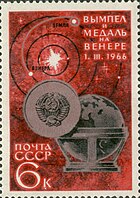 | |
| Mission type | Venus atmospheric probe with flyby spacecraft |
|---|---|
| Operator | OKB-1 |
| COSPAR ID | 1965-092A |
| SATCAT no. | 1733 |
| Mission duration | 105 days |
| Spacecraft properties | |
| Spacecraft | 3MV-3 No.1 |
| Manufacturer | Lavochkin |
| Launch mass | 960 kg (2,120 lb) |
| Landing mass | 377 kg (831 lb) |
| Dimensions | 4.2 m × 1.1 m (13.8 ft × 3.6 ft) |
| Start of mission | |
| Launch date | 16 November 1965, 04:19 UTC |
| Rocket | Molniya |
| Launch site | Baikonur 31/6 |
| Orbital parameters | |
| Reference system | Heliocentric |
| Perihelion altitude | 0.68 AU |
| Aphelion altitude | 0.99 AU |
| Inclination | 4.29° |
| Period | 277 days |
| Venus impact (failed landing) | |
| Impact date | 1 March 1966 |
| Impact site | 20°N 80°E / 20°N 80°E |
Venera 3 (Russian: Венера-3 meaning Venus 3) was a Venera program space probe that was built and launched by the Soviet Union to explore the surface of Venus. It was launched on 16 November 1965 at 04:19 UTC from Baikonur, Kazakhstan, USSR. The probe comprised an entry probe, designed to enter the Venus atmosphere and parachute to the surface, and a carrier/flyby spacecraft,[1][2] which carried the entry probe to Venus and also served as a communications relay for the entry probe.
- ^ Wade, Mark. "Venera 3MV-3". Encyclopedia Astronautica. Archived from the original on 28 December 2016. Retrieved 3 April 2018.
- ^ Krebs, Gunter. "Venera 3 (3MV-3 #1)". Gunter's Space Page. Retrieved 3 April 2018.